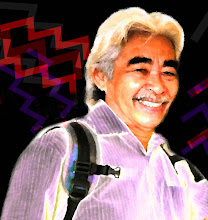With the aid of the mighty chainsaw, our morning's work in cutting this extremely hard fallen log of the
belian tree was carried out doubly fast. Below is the view of the footpath from the east and
Ati is somewhere in the middle of the footpath. There are at least 50 species of trees within this small vegetation island. I have not yet
inventoried the trees. My knowledge of the trees of Sarawak is limited. I think when I am free in future I will seek the assistance of my class mate who worked with the Forestry Department till retirement to name the species found here.

Anyway, the species that stood in our way in the picture
above is the familiar
belian species (
Eusideroxylon melagangai). Here in Sarawak and just as well in Brunei, we use
belian timber to build our
traditional houses because it its the hardest tree available in Borneo Island,
well you can say that it is equivalent to the teak tree of
Thaliand. In
Bintulu's kampungs today you can still see the houses
built totally of
belian from posts to shingles intact even after 80 years ago. Of course the
belian posts can last a lifetime even when
submerged in water. Life time means , yes a hundred years.
Belian timber never rot .

The above picture is
taken from the proposed top footpath.The' sassy pink' footpath can be slightly seen from the picture i.e. the the lower section of the hill.

And finally , the footpath is more or less delineated and cleared. I think planting can proceed tomorrow. Not bad for a good
morning's workout.

View of the footpath from the west. Total
man hours spent = 10
man hours,
Ati and me
included.

































.jpg)


